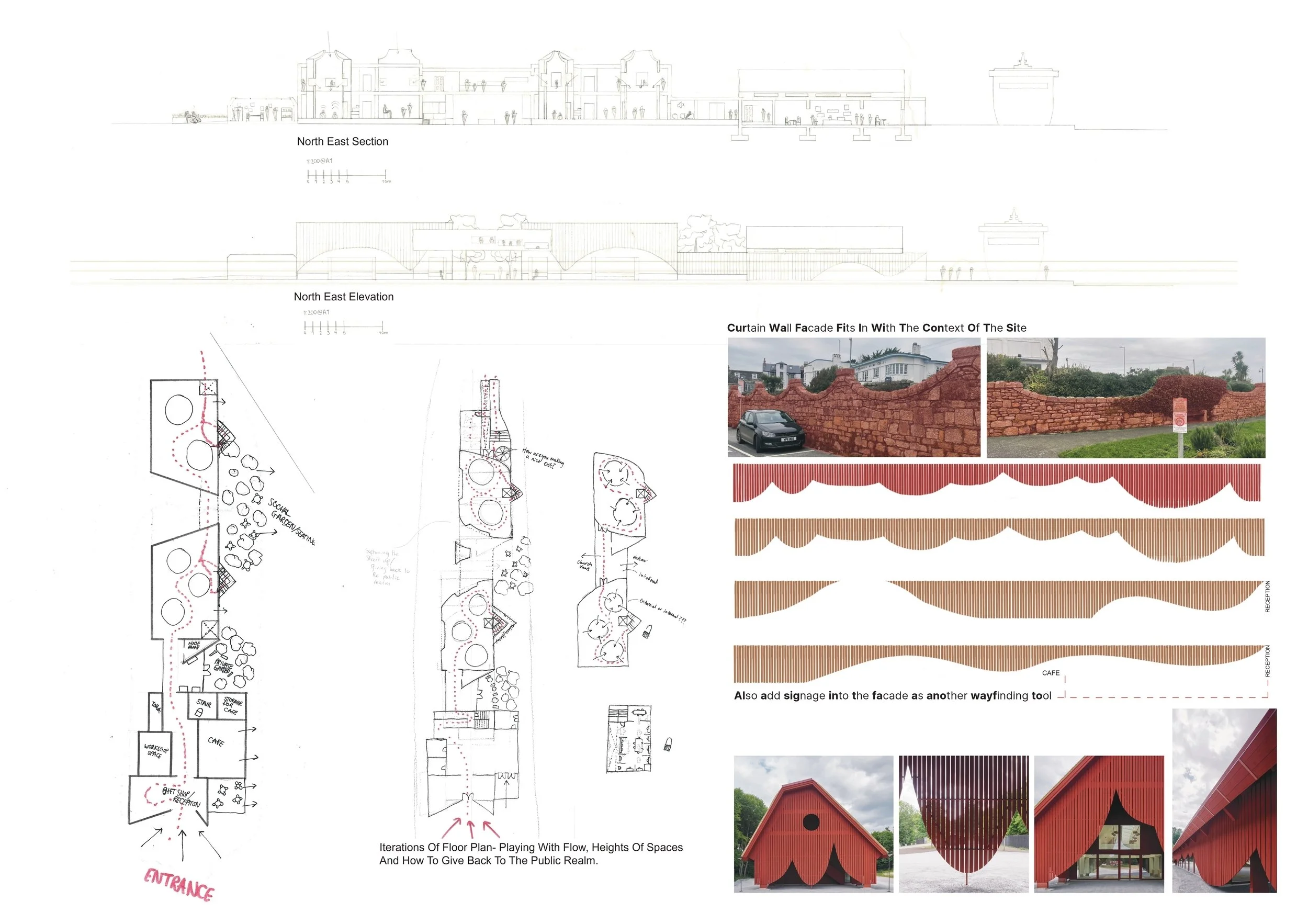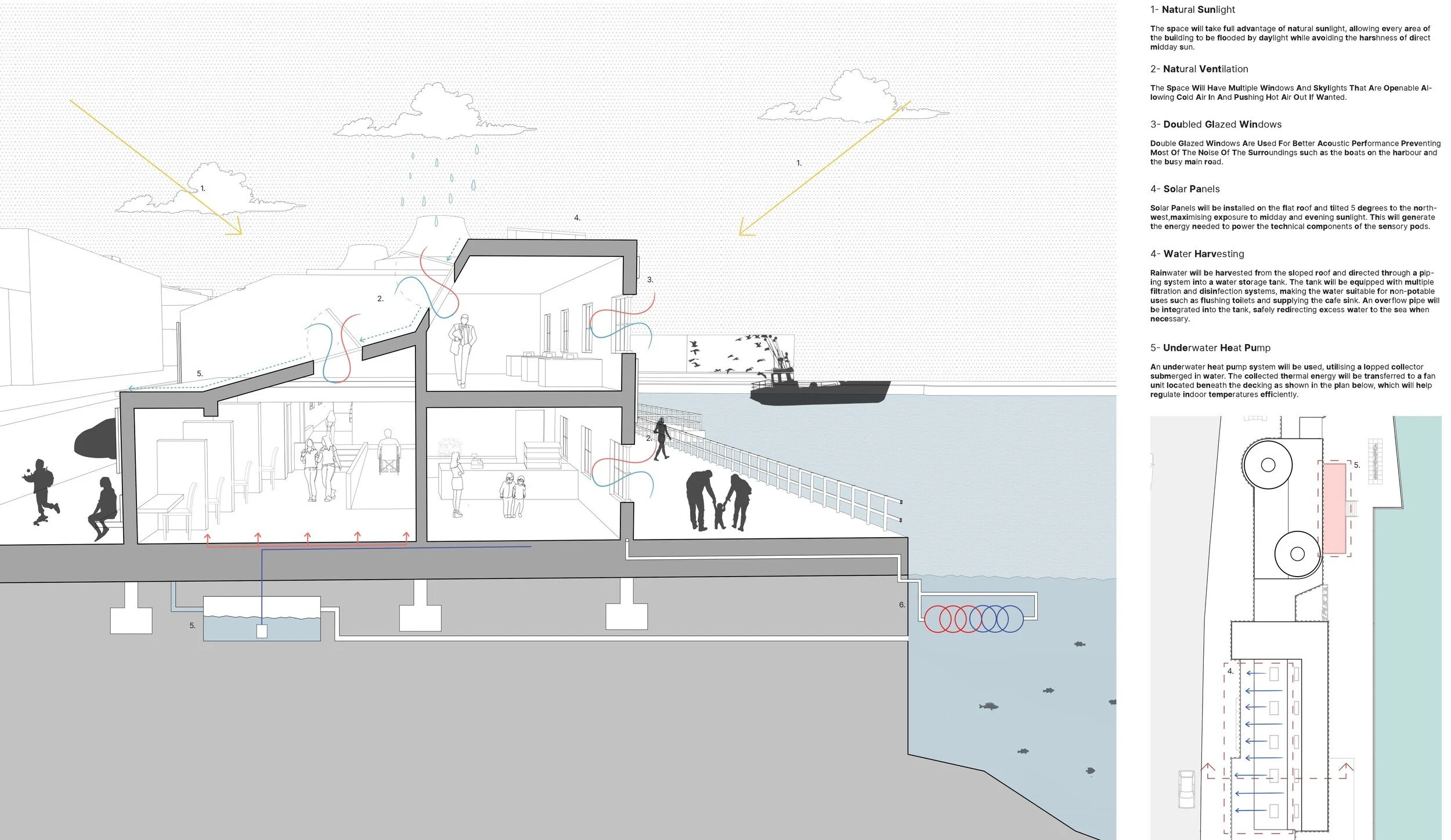UNIT H
Unit H explores the mechanisms and dynamics of gathering people in public spaces. This year, the unit investigated the intricate relationship between architecture, culture, and the socio-economic development of places, with a critical lens on the “Bilbao effect” and its impact on local communities. We focused on how architecture can responsibly support tourism and cultural production, going beyond mere spectacle to create meaningful contributions to a place.
The site is located in Penzance, West Cornwall and the brief is centred around making a true connection with a place’s art and culture scene. Looking to the region’s towns and rural areas, which have long been celebrated places in the production of culture through a thriving arts scene founded in the early 19th Century, we aimed to address the question: How can a Sustaining Museum contribute to developing cultural activity and a ‘working’ art world that more directly enriches the local community and economy?
Tutors: Felicity Barbur, Kitty Byrne, Eugenio Cappuccio, Sonia Ballance - Technology tutor, Matthew Bolton - Structures
Students: Joonyoung Ahn, Therese Airiemiokhale, Angel Bagatan, Alexandra Beňová, Cristina Evagorou, Poppy Gwilliams, Victoria Jakowlew, Samuel Kidd, Thishn Manmatharajan, Rishikaa Vinay Saxena, Chris Wang, Wafa Ahmed, John Francis Bayot Angcaya, Owen Clarke, Oskar Domagala, Gala Kaptieva, Danil Kiose, Dominika Okon, Elene Robakidze, Cameron Templeton, Giulia Thorpe, Abi Wallis, Shangming Wu
The Festivalia Hub
Cristina Evagorou
Reflecting on this year’s unit brief, the main concept for this project revolves around sustaining existing communities. Creating spaces such as music and dance studios, educational spaces, fabric studios and an exhibition space, this idea is an all-in-one concept to support the local community's needs, in festival production and hosting, and a purpose for people to visit the area.
Located in Penzance, Cornwall, the site given is a run-down, unused space along with a Meadery that is still open for service; however, as it is situated on a busy road with restricted pedestrian access, it isn’t easy to gain attraction. This leads to the area becoming deprived of its residents and visitors. Cornwall is known for its cultural celebrations, including May Day, Golowan, Mazey Day, the Guldize festival, Allantide, and Montol, which are significant community events that take place throughout the year. As it turns out, all of these are celebrated in Penzance, which marks the beginning of this project.
There is a lot of effort that goes on backstage in order to prepare for these festivals, yet the people who take part in these parades don’t exactly have the space or storage for these activities. This cultural hub provides spaces that fit those needs by having a front face of an all-year-round exhibition, providing visual information using costumes, also acting as a storage for those items. Props and posters signpost to the public what is happening at that current time. The ‘backstage’ of the hub holds all the creative spaces where costumes are made in the fabric studio, cultural stories are taught to children in the educational spaces, and music is created in the practice rooms. These inputs are all brought together to present the festivals for the community to enjoy. The exhibition is designed as a colonnade which creates a new purpose for the existing pathway as well as enhancing its accessibility, leading to more attraction to the site. It also blends within the backstage idea to double up as a production space to create large-scale floats, providing space for public viewing as well as a large creation area.
The Festivalia Hub supports the local Penzance community to sustain the traditional Cornish festivals, engaging with what the community is proud to present, enabling people to visit and learn what Cornish Culture is all about.
Brief Development
Highlighting the Spaces
Ground Floor Plan
CAD Elevations
Environmental Section
May Horns Rendered Elevation
Montol Rendered Elevation
Guldize Festival Rendered Section
Allantide Rendered Perspective
Golowan & Mazey Day Rendered Perspective
The Sensory Climate Action Hub
Owen Clarke
Reimagining The Traditional Museum: A Sensory Climate Action Hub for Penzance
Unit H’s second semester brief challenged students to design a sustaining museum that positively impacts the local community and economy of Penzance located in Cornwall. This brief lead to the project “A Sensory Climate Action Hub”, a project that redefines the traditional museum as an educational center designed to raise awareness about climate change and its direct impact on Penzance. These issues will be explored through immersive, sensory based experiences, creating an experience that hasn’t been done before.
The main goal of this museum was to design with inclusivity and accessibility at the forefront of
the design process, designing a space for people who wouldn’t normally be able to access a traditional museum, particularly neurodiverse individuals, who frequently encounter environments that feel hostile to them.
This concept was inspired by a physical college highlighting how neurodiverse needs are often neglected in the design process, even though it’s estimated that 1 in 7 people in the UK identify as neurodiverse making up a sizeable chunk of our population.
Hence the sensory aspect of this museum, as sensory activities have been proven to improve language and communication, regulate emotions and attentions, aid focus, have a calming effect and improve motor skills and coordination. For these reasons, they are commonly used by therapists, parents and educators to create more supportive environments for neurodiverse individuals.
Collage
Design Process
Design Process 2
Detail Drawing
Elevations
Enviromental Mode
First Floor Plan
Ground Floor Plan
Isometric Drawing Of The Whole Building In Context
Section



















